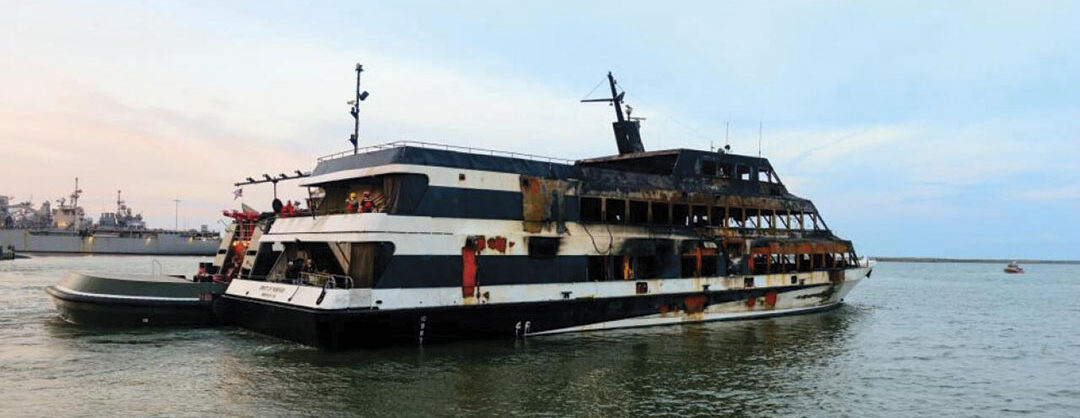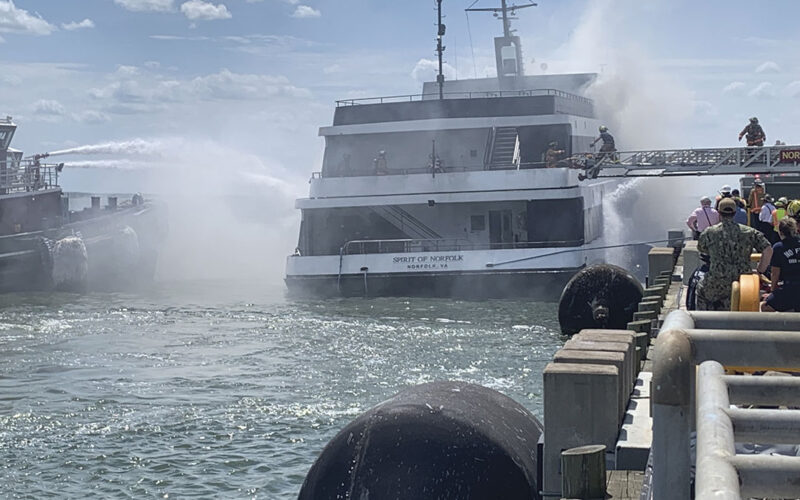
The fire that started during a Norfolk, Va., harbor cruise began in the engine room near a generator exhaust pipe, federal investigators said.
Spirit of Norfolk was halfway through a lunchtime cruise on June 7, 2022, when crew saw smoke coming from portside engine room exhaust vents, according to the National Transportation Safety Board (NTSB).
The crew aboard the 169-foot steel ship mobilized quickly and secured fuel supplies to both engines and directed passengers and hospitality crew to an outside deck away from the smoke. All 108 passengers and crew escaped without injury, with most disembarking onto Good Samaritan vessels.
The 30-year-old ship, which was valued at about $5 million, burned for four days at a Naval Station Norfolk pier and was declared a total loss.
The NTSB traced the fire to combustible materials left too close to portside generator exhaust piping. Although investigators acknowledged the ignition source could not be definitively determined, they found that the flames started outboard of the port main engine in an area where combustible materials were stored.

The agency cited the ship’s lack of engine room fire detection and fixed fire suppression as contributing factors in the blaze. The ship was not required under existing U.S. Coast Guard regulations to have either system.
“Also contributing to the severity were ineffective communications between the unified command and firefighting teams that led to the fire attack team opening the engine room door, allowing the fire to spread,” the NTSB said in its fall 2023 report.
The captain helming Spirit of Norfolk was a recent hire and a veteran captain was also on board to oversee his training. The new-hire captain prepared to top around in the Elizabeth River and return to downtown Norfolk when the port engine suddenly quit. He looked aft and saw smoke coming from the exhaust vents.
Crew members used a watertight door in the galley to access the engine room. Facing thick smoke, they realized hand-held fire extinguishers were not up to the task, the report said.
The ship’s captain reported the situation over VHF radio using channels 13 and 16. Several monitor-equipped tugboats responded, blasting water into the engine room vents and the small passenger boat Victory Rover came alongside to evacuate passengers, which included dozens of students from a local elementary school.
Some 45 minutes after the fire started, several tugboats towed the burning ship to Pier 4 at Naval Station Norfolk and a unified command was formed with teams from multiple local departments and the U.S. Navy.
Prior to departing the ship, Spirit of Norfolk’s captain gave firefighters access to the ship’s fire control plan and directed them to an escape hatch to enter the engine room without opening a watertight door from the galley.
A four-person firefighting team boarded the ship at about 2:10 pm. The team entered the engine room and with thick, heavy smoke and fire overhead, they were unable to locate the engine room escape hatch. Within a half-hour, the team applied foam to the engine compartment through the hatch and found that visibility was even worse on the main deck, which also was hotter than it was just 30 minutes earlier.
“Unable to find the emergency escape hatch, they went to the engine room door at the aft end of the galley,” the report said. “As a member of the team turned the wheel on the watertight door to the engine room, the door exploded open causing…a minor back draft into the galley.”
Ashore, the report continued, “responders heard a loud noise and saw the vessel ‘shift to port hard…[and] appear like it was going to roll.’”
The attack team quickly departed the vessel, but left the engine room door open, allowing the fire to spread throughout the ship as the lack of dampers in the engine room allowed a steady flow of outside air to feed the fire.
At about 8:00 pm, the Coast Guard established a new unified command with a wider group of participants. DonJon-Smit salvage teams began dewatering activities the following day with pumps quickly filling dockside tanks.
A barge arrived soon after midnight on June 9 to pump water from the burning vessel. By midafternoon, some 190,000 gallons had been pumped from the ship and the fire was declared out at 10:00 am on June 11.
The gutted hulk of Spirit of Norfolk was later towed to the Colonna’s Shipyard in Norfolk where NTSB officials conducted their investigation into the cause of the fire.
The incident highlighted challenges presented by the initial unified command. Both Norfolk city officials and the U.S. Navy declined to participate in the NTSB investigation, making it unclear “whether the fire attack team was aware of how much firefighting water had accumulated in the engine room or the structural fire protection that the engine room door provided.”
The broader incident, the agency stated, also highlighted the need for new regulations targeting better fire prevention protocols and systems for small passenger boats.
The fire, it concluded, could have been extinguished soon after it started had the engine room been equipped with a fixed fire suppression system and ventilation closures.
“It is time for the U.S. Coast Guard to remove the exemption from the Subchapter K regulations,” said NTSB Chairwoman Jennifer Homendy. “More than 100 of these exempted small passenger vessels are currently operating without fire detection or firefighting systems in their engine rooms while carrying hundreds of passengers.”
The current situation, she stated, pose “a completely unnecessary risk to passengers and crew,” but, as of press time, no action had been taken by the Coast Guard.

